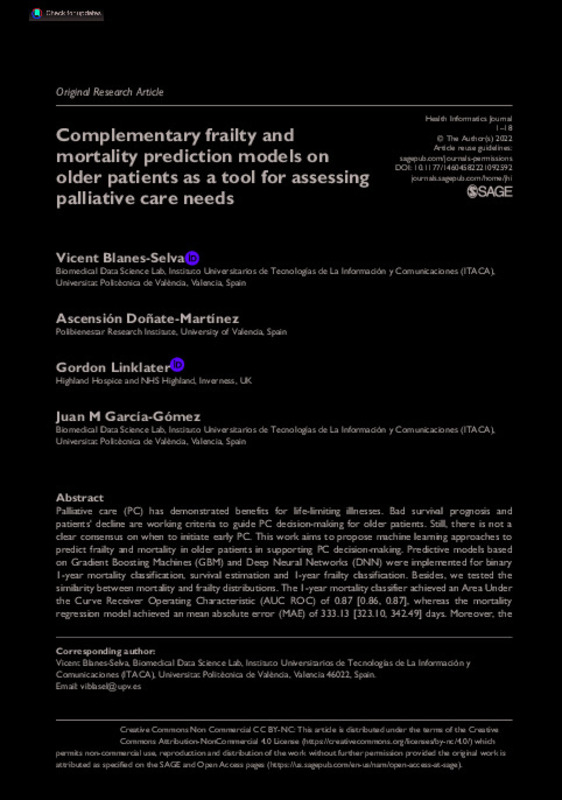JavaScript is disabled for your browser. Some features of this site may not work without it.
Buscar en RiuNet
Listar
Mi cuenta
Estadísticas
Ayuda RiuNet
Admin. UPV
Complementary frailty and mortality prediction models on older patients as a tool for assessing palliative care needs
Mostrar el registro sencillo del ítem
Ficheros en el ítem
| dc.contributor.author | Blanes-Selva, Vicent
|
es_ES |
| dc.contributor.author | Doñate-Martínez, Ascensión
|
es_ES |
| dc.contributor.author | Linklater, Gordon
|
es_ES |
| dc.contributor.author | Garcia-Gomez, Juan M
|
es_ES |
| dc.date.accessioned | 2023-10-19T18:01:25Z | |
| dc.date.available | 2023-10-19T18:01:25Z | |
| dc.date.issued | 2022-04 | es_ES |
| dc.identifier.issn | 1460-4582 | es_ES |
| dc.identifier.uri | http://hdl.handle.net/10251/198408 | |
| dc.description.abstract | [EN] Palliative care (PC) has demonstrated benefits for life-limiting illnesses. Bad survival prognosis and patients' decline are working criteria to guide PC decision-making for older patients. Still, there is not a clear consensus on when to initiate early PC. This work aims to propose machine learning approaches to predict frailty and mortality in older patients in supporting PC decision-making. Predictive models based on Gradient Boosting Machines (GBM) and Deep Neural Networks (DNN) were implemented for binary 1-year mortality classification, survival estimation and 1-year frailty classification. Besides, we tested the similarity between mortality and frailty distributions. The 1-year mortality classifier achieved an Area Under the Curve Receiver Operating Characteristic (AUC ROC) of 0.87 [0.86, 0.87], whereas the mortality regression model achieved an mean absolute error (MAE) of 333.13 [323.10, 342.49] days. Moreover, the 1-year frailty classifier obtained an AUC ROC of 0.89 [0.88, 0.90]. Mortality and frailty criteria were weakly correlated and had different distributions, which can be interpreted as these assessment measurements are complementary for PC decision-making. This study provides new models that can be part of decision-making systems for PC services in older patients after their external validation. | es_ES |
| dc.description.sponsorship | The author(s) disclosed receipt of the following financial support for the research, authorship, and/or publication of this article: This work was supported by the InAdvance project (H2020-SC1-BHC-2018-2020 No. 825750). | es_ES |
| dc.language | Inglés | es_ES |
| dc.publisher | SAGE Publications | es_ES |
| dc.relation.ispartof | Health Informatics Journal | es_ES |
| dc.rights | Reconocimiento - No comercial (by-nc) | es_ES |
| dc.subject | Palliative care | es_ES |
| dc.subject | Machine learning | es_ES |
| dc.subject | Deep learning | es_ES |
| dc.subject | Frailty | es_ES |
| dc.subject | Mortality | es_ES |
| dc.subject | Older patients | es_ES |
| dc.subject | Needs assessment | es_ES |
| dc.subject.classification | FISICA APLICADA | es_ES |
| dc.title | Complementary frailty and mortality prediction models on older patients as a tool for assessing palliative care needs | es_ES |
| dc.type | Artículo | es_ES |
| dc.identifier.doi | 10.1177/14604582221092592 | es_ES |
| dc.relation.projectID | info:eu-repo/grantAgreement/EC/H2020/825750/EU | es_ES |
| dc.rights.accessRights | Abierto | es_ES |
| dc.contributor.affiliation | Universitat Politècnica de València. Escuela Técnica Superior de Ingenieros Industriales - Escola Tècnica Superior d'Enginyers Industrials | es_ES |
| dc.description.bibliographicCitation | Blanes-Selva, V.; Doñate-Martínez, A.; Linklater, G.; Garcia-Gomez, JM. (2022). Complementary frailty and mortality prediction models on older patients as a tool for assessing palliative care needs. Health Informatics Journal. 28(2):1-18. https://doi.org/10.1177/14604582221092592 | es_ES |
| dc.description.accrualMethod | S | es_ES |
| dc.relation.publisherversion | https://doi.org/10.1177/14604582221092592 | es_ES |
| dc.description.upvformatpinicio | 1 | es_ES |
| dc.description.upvformatpfin | 18 | es_ES |
| dc.type.version | info:eu-repo/semantics/publishedVersion | es_ES |
| dc.description.volume | 28 | es_ES |
| dc.description.issue | 2 | es_ES |
| dc.identifier.pmid | 35642719 | es_ES |
| dc.relation.pasarela | S\466233 | es_ES |
| dc.contributor.funder | COMISION DE LAS COMUNIDADES EUROPEA | es_ES |
| upv.costeAPC | 1210 | es_ES |








